Imagine biting into a juicy slice of watermelon on a hot summer day. The sweet, refreshing taste instantly transports you to sunny afternoons and backyard picnics. But what if I told you that the secret to achieving that perfect watermelon lies not just in the seeds you plant, but in the company they keep? That’s right! By choosing the best companion plants for watermelon, you can enhance growth, boost flavor, and even fend off those pesky pests. In this article, you’ll discover helpful watermelon gardening tips that will allow you to cultivate a thriving garden full of delicious and healthy watermelons. Together, let’s explore the magical world of companion planting, where harmony among plants leads to flourishing results.
Key Takeaways
- Choosing the right watermelon companion plants can enhance growth and flavor.
- Companion planting helps in pest control and improves soil health.
- Understanding plant relationships can lead to a more bountiful harvest.
- Effective spacing and timing are crucial for garden success.
- Experimenting with various companions can yield surprising benefits.
What Are Companion Plants for Watermelon?
Companion planting with watermelon involves strategically pairing plants in a way that they enhance each other’s growth. This method utilizes the natural interactions between different plants to create a garden ecosystem that supports healthier plants and higher yields. Understanding what watermelon plant companions work best is crucial for reaping the full benefits of this gardening technique.
Definition and Benefits
Companion plants are species that offer mutual advantages when grown near one another. For watermelon, these companions can repel pests, foster beneficial insect populations, and improve soil health. By implementing effective companion planting strategies, you can cultivate a thriving garden environment that encourages biodiversity while minimizing the need for chemical interventions.
The Role of Companion Plants in Gardening
The significance of companion planting with watermelon extends beyond mere aesthetics. These relationships help in creating a balanced ecosystem by:
- Reducing pest populations that threaten watermelon crops.
- Attracting pollinators essential for fruit development.
- Enhancing soil nutrient levels through natural interactions.
- Providing shade or protection from harsh weather, ensuring your watermelon thrives in various conditions.
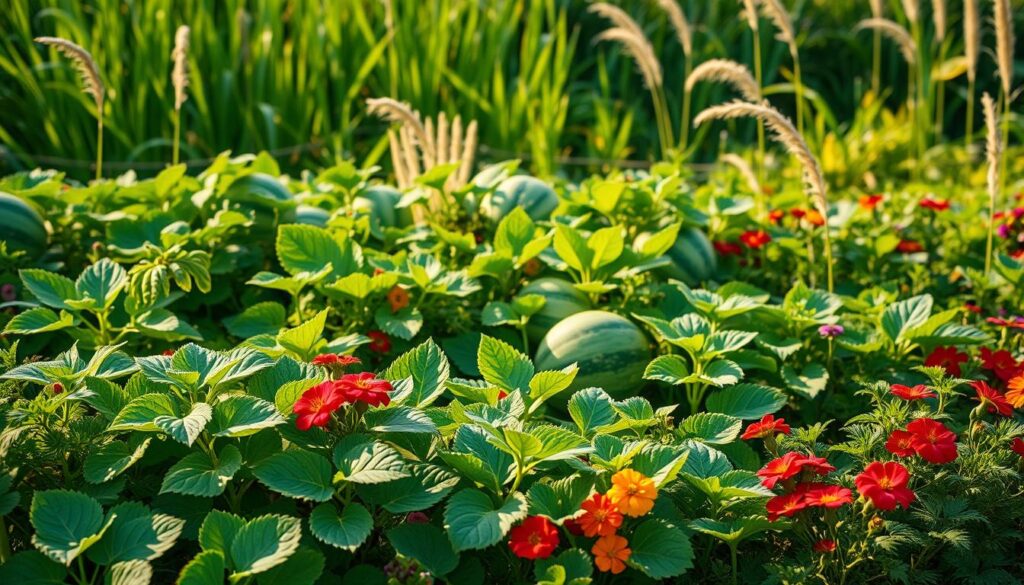
| Advantage | Description |
|---|---|
| Pest Control | Companion plants can deter harmful insects, reducing the reliance on pesticides. |
| Attraction of Beneficial Insects | Some plants attract pollinators and predatory insects that help in pest management. |
| Soil Enhancement | Some companions improve soil fertility by fixing nitrogen or adding organic matter as they decompose. |
| Microclimate Creation | Companion plants can create shade or shield watermelons from wind, optimizing their growing conditions. |
Why Watermelons Need Companion Plants
Watermelons thrive in gardens where their needs are met through a combination of nutrient-rich soil and effective pest management. By integrating companion plants, you can significantly enhance the garden ecosystem, resulting in healthier watermelons. This strategy aligns well with organic gardening with watermelon principles, focusing on sustainable practices that yield fruitful results.
Improving Soil Health
Companion plants play a crucial role in enriching soil health. Leguminous plants are particularly beneficial, as they fix nitrogen in the soil, enhancing its fertility. This natural enrichment process leads to improved drainage and aeration, which is vital for the healthy development of watermelon roots. As a gardener, you can ensure that your watermelon plants receive the nutrition they require, promoting optimal growth.
Pest Control and Prevention
Effective pest control methods are essential for maintaining the health of your watermelon plants. Certain companion plants, such as marigolds, can naturally deter pests like aphids and cucumber beetles, protecting your prized watermelons without the need for chemical interventions. Embracing these natural defense strategies allows you to cultivate a thriving garden environment, reducing the risks associated with traditional pest management techniques.
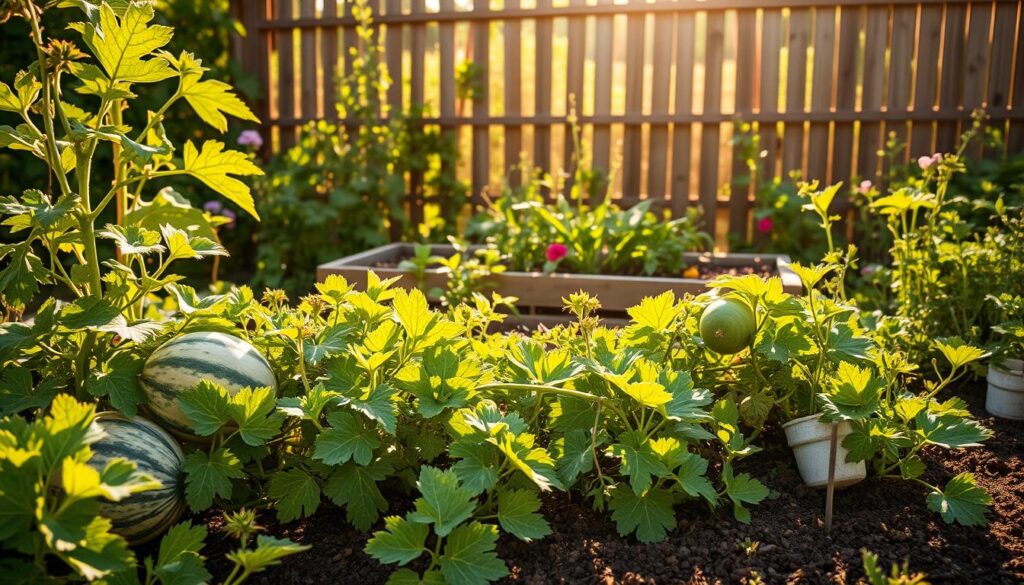
The Best Companion Plants for Watermelon
Finding the best companion plants for watermelon can significantly enhance your garden’s health and productivity. These watermelon garden companions not only coexist well with watermelon but also provide various benefits ranging from pest control to improved soil quality. Here are some excellent choices to consider.
Basil: A Flavorful Friend
Basil is renowned for its aromatic leaves, but its benefits stretch beyond the kitchen. This herb repels pests such as aphids and spider mites, creating a protective barrier around your watermelon plants. By planting basil nearby, you may find your watermelon thriving while enjoying the fresh flavor basil adds to your culinary creations.
Marigolds: Natural Pest Deterrents
Incorporating marigolds into your garden can prove highly beneficial as they release compounds that deter harmful pests like aphids and nematodes. These vibrant flowers not only brighten your garden but also act as a shield for your watermelon plants, making them one of the most effective watermelon garden companions.
Radishes: Helping with Root Development
Radishes are quick-growing plants that can help improve soil aeration and structure. As radishes mature, they work to loosen the soil, which benefits the root systems of your watermelon plants. Their presence also helps deter pests like cucumber beetles, ensuring that both your radishes and watermelons can flourish together.

| Companion Plant | Benefits | Pest Control |
|---|---|---|
| Basil | Enhances flavor and aroma | Repels aphids and spider mites |
| Marigolds | Natural pest deterrent | Deters aphids and nematodes |
| Radishes | Improves soil structure | Discourages cucumber beetles |
Herbs That Benefit Watermelon Growth
Incorporating herbs into your garden not only enriches the culinary experience but also boosts the overall health of your plants. Watermelon companion plants like thyme and cilantro play pivotal roles in creating a flourishing garden. These herbs are valuable additions, providing both ecological benefits and enhanced flavor to your harvest.
Thyme: A Companion with Many Benefits
Thyme acts as a natural pest deterrent, keeping harmful insects at bay. Its presence can help improve the resilience of your watermelon plants, promoting healthier growth. Integrating thyme into your garden’s layout enhances the effectiveness of companion planting strategies, simultaneously benefiting both the herbs and the watermelons.
Cilantro: Attracting Beneficial Insects
Cilantro serves as a magnet for beneficial insects that naturally control pests, crucial for preventing infestations. These insects enhance pollination, promoting the fertilization of watermelon flowers. By including cilantro with your watermelon companion plants, you create a balanced ecosystem that supports biodiversity while maximizing potential yields.

Vegetables That Pair Well with Watermelon
Choosing the right vegetables for companion planting with your watermelon can lead to a thriving garden. Two standout options are cucumbers and corn. Both of these vegetables contribute positively to the growing environment of watermelons, enhancing overall productivity.
Cucumbers: Tight Space Utilizers
Cucumbers are an excellent choice for maximizing garden space while complementing watermelon plants. Their sprawling vines can cover ground effectively, providing a lush green carpet. This growth habit helps retain soil moisture, which is essential for watermelons. When planting cucumbers alongside watermelons, ensure you provide ample room for both to flourish.
Corn: Acting as Natural Shade
Corn serves a dual purpose in the garden. It acts as a natural shade provider, which is particularly beneficial during the hottest hours of the day. Watermelons thrive in the right light conditions, and shade from corn can help reduce heat stress. Utilizing corn as a vertical element can create a microclimate that supports watermelon growth. When combined with effective watermelon gardening tips, such planting strategies can lead to a healthier and more productive garden.
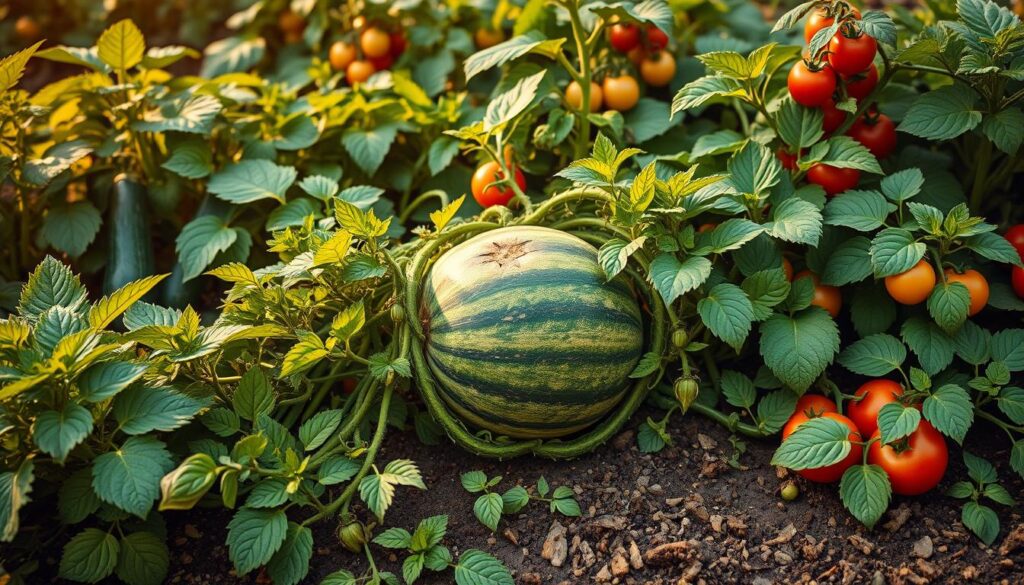
| Vegetable | Benefits for Watermelon |
|---|---|
| Cucumbers | Maximizes space and retains soil moisture |
| Corn | Provides shade and creates a supportive microenvironment |
Flowers That Attract Pollinators
Incorporating colorful flowers in your garden can greatly enhance the pollination process. By choosing the right blooms, you not only add beauty but also attract vital pollinators like bees. Flowers such as zinnias and sunflowers serve as excellent watermelon plant companions, creating a vibrant ecosystem that benefits your crops.
Zinnias: Brightly Colored Bee Magnets
Zinnias are known for their striking colors and easy maintenance, making them an ideal choice for gardeners. Their bright blooms effectively attract pollinators, stimulating fertilization in watermelon plants. A garden adorned with zinnias not only looks stunning but significantly increases the chances of a fruitful watermelon harvest.
Sunflowers: Tall Allies for Pollination
Sunflowers stand tall and proud, offering more than just aesthetic appeal. These flowers act as a natural trellis for climbing plants and help create a welcoming environment for bees and other pollinators. Placing sunflowers near your watermelon plants can lead to a lush garden filled with fruitful yield.

| Flower Type | Color | Height | Attracts Pollinators |
|---|---|---|---|
| Zinnias | Various | 1-3 feet | Yes |
| Sunflowers | Yellow | 5-10 feet | Yes |
Utilizing these flowers in your garden aims to enhance pollination while improving the overall health of your watermelon plants. With zinnias and sunflowers by your side, you can create a thriving garden landscape.
Plants to Avoid Near Watermelon
Choosing the right companions for your watermelon is crucial, but being aware of harmful companion plants is equally important. Certain plants can negatively impact the growth and health of your watermelon crops by competing for resources or introducing diseases. Here are some plants to avoid to keep your watermelon flourishing.
Other Melons: Competition for Resources
Growing other melons in close proximity to watermelon can lead to increased competition for nutrients and water. This competition may stunt growth and reduce the overall yield of your crops. It’s best to space out any melon varieties to ensure each plant receives adequate resources.
Potatoes: Risking Disease Spread
Potatoes are another of the harmful companion plants to keep away from watermelons. They can harbor diseases such as blight, which can easily spread to watermelon plants in the same garden. Additionally, the pest attraction associated with potatoes can lead to further challenges for your watermelon plants.

Best Practices for Planting Companion Plants
When engaging in effective companion planting, timing and spacing become crucial factors that significantly influence your garden health. Sowing seeds at the right moments ensures that plants can thrive without competing for light and nutrients. This creates a harmonious growing environment where each plant supports the others, optimizing the garden space.
Timing and Spacing Considerations
Understanding the growth patterns of your plants will help you decide the best times to plant your companions. For instance, you should consider the specific maturity rates of each plant. Aligning planting schedules can minimize shading and promote better growth outcomes. Aim for a calculated spacing layout, allowing each plant sufficient room to flourish without overcrowding.
Monitoring Plant Health
Regularly check the plants for any signs of stress, disease, or pest issues, as early detection allows for timely intervention. Keeping a close eye on your garden’s health can lead to more robust yields and flourishing plants. Utilize organic practices such as companion planting to naturally deter pests while boosting overall garden vitality.
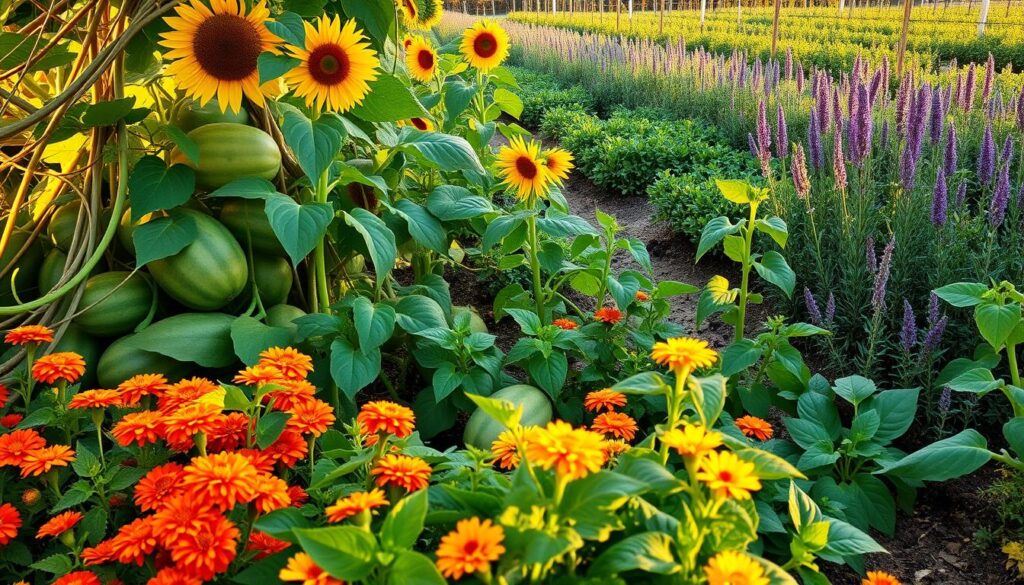
Understanding Watermelon Growth Requirements
For successful watermelon gardening, it is essential to know the specific growth requirements of this juicy fruit. By grasping these basic needs, you will be better prepared to cultivate delicious watermelons and improve your chances of a bountiful harvest.
Sunlight and Soil Preferences
Watermelons require full sun exposure, ideally at least six hours of direct sunlight each day. This sunlight is crucial for the photosynthesis process, which aids in the growth and sweetness of the fruit. Soil quality is another vital aspect. Watermelons thrive in well-draining soil that is rich in organic matter. A pH range of 6.0 to 6.8 is optimal for their growth, ensuring that essential nutrients are available.
Watering Techniques
Effective watering techniques make a significant difference when growing watermelon effectively. Watermelons need consistent moisture, particularly during flowering and fruit development stages. It’s best to water deeply and less frequently to encourage deep root growth. During dry periods, ensure that the soil remains adequately moist, as this will help produce the juicy, sweet fruit that watermelons are known for.
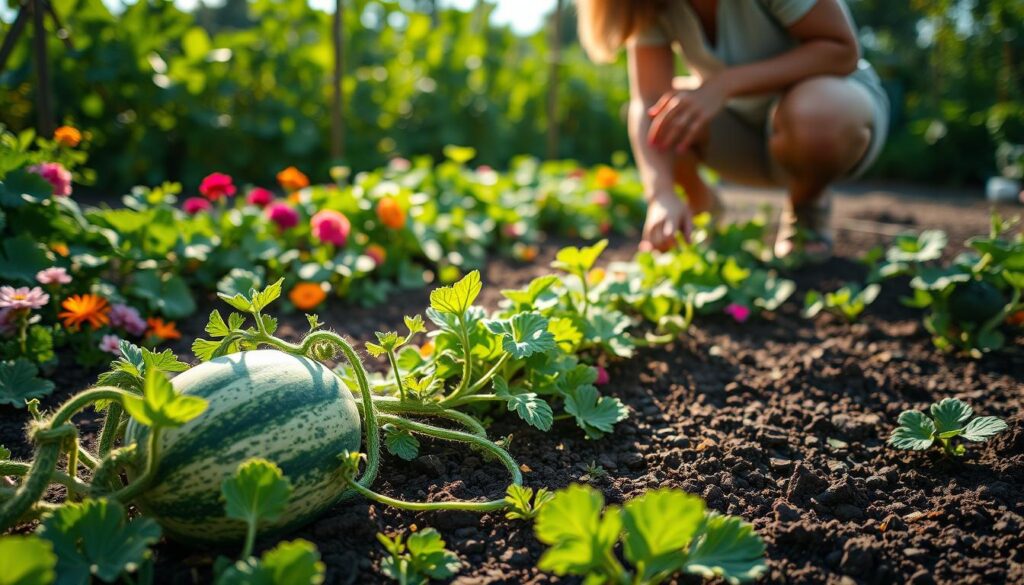
Using Companion Plants to Enhance Flavors
In culinary gardening, the right companion plants can significantly influence the flavor profile of your watermelon. By choosing suitable herbs and vegetables to grow alongside your watermelon, you can create a delightful harmony of tastes and aromas in your garden. Certain herbs, such as basil and mint, can contribute to subtle flavor enhancements, making your watermelon even more enjoyable.
How Companion Plants Affect Watermelon
Companion plants are known to affect the overall health and productivity of watermelon. When you plant basil near watermelon, the herb releases compounds that can subtly enhance the fruit’s natural sweetness. Similarly, mint can add a refreshing note to the flavor profile. These interactions not only support plant health but also enrich your culinary experience.
Culinary Benefits of Growing Together
Integrating companion plants into your garden can elevate the way you enjoy watermelon. The combination of flavors served fresh from your garden enhances your dishes, making meals more exciting. Experimenting with various plant pairings can lead to exciting discoveries in taste, ultimately boosting your enjoyment of homegrown produce.
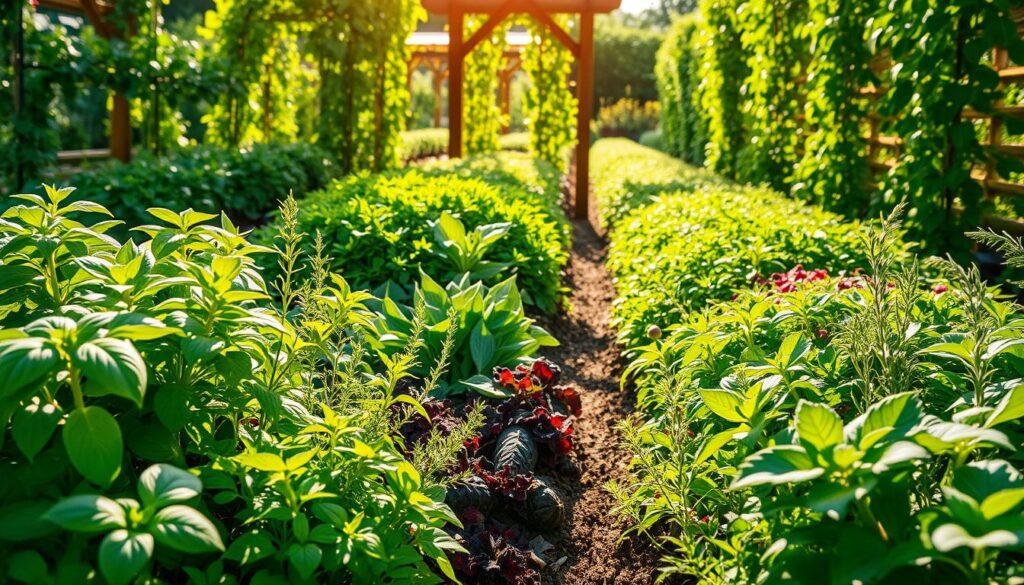
The Role of Companion Plants in Organic Gardening
Incorporating companion plants into your gardening practice serves as an excellent approach for organic gardening strategies. These plants offer a variety of benefits that contribute to a healthier garden ecosystem. By understanding how companion plants can create a natural balance, you can enhance your gardening experience and productivity without relying on synthetic chemicals.
Pest Management Without Chemicals
Utilizing companion plants allows you to manage pests effectively in your garden. Certain plants naturally repel harmful insects while attracting beneficial predators. This creates a balanced environment where pest populations remain in check. By focusing on organic gardening strategies, you avoid harmful impacts on both your crops and local wildlife.
Enhancing Biodiversity
Promoting biodiversity in gardens nurtures various species, which is crucial for the overall health of your garden. Companion planting encourages a greater diversity of flora and fauna, helping to establish habitats for pollinators and other beneficial organisms. These efforts not only enhance your garden’s beauty but also ensure a thriving ecosystem.

Incorporating various companion plants offers long-term benefits for your garden. By embracing these natural methods, you align with principles of organic gardening while cultivating a vibrant and productive gardening space.
Seasonal Considerations for Companion Planting
Timing plays a crucial role in seasonal gardening, particularly when it comes to companion planting. Spring marks an excellent time to sow heat-loving plants like watermelons alongside their beneficial companions. It sets up a harmonious growth environment where plants can thrive together. Meanwhile, late summer opens up a realm of opportunities for planting crops that can fill in the gaps as watermelons reach maturity. Understanding the right planting times will enhance your garden’s productivity and vitality.
Spring Planting Strategies
In spring, focus on planting heat-tolerant companion plants. The warmth encourages growth, allowing for a robust garden environment. Pair watermelon with plants such as basil and marigolds during this period. These companions not only support the growth of watermelon but also provide natural pest control. This tactical planting will create a supportive ecosystem that benefits all plants involved.
Late Summer Companion Options
As the summer winds down, consider adding late-season crops that complement your watermelons. This may include quick-growing varieties like radishes or certain leafy greens. These plants can take advantage of the remaining warm weather and contribute to a bountiful harvest. Identifying the right late summer planting times ensures your garden remains lively and productive even as the warmth begins to fade.

How to Introduce Companion Plants to Your Garden
Successfully incorporating companion plants involves thoughtful planning and execution. Utilizing effective companion planting methods can enhance growth, improve pest control, and promote overall garden health. Here are some essential garden layout tips and a step-by-step guide for effectively introducing companion plants into your existing setup.
Planning Your Garden Layout
Before you start planting, develop a comprehensive garden layout. Consider these points:
- Space Allocation: Ensure adequate space for both watermelons and their companions to thrive without overcrowding.
- Growth Characteristics: Match companion plants based on their growth height and spread to optimize sunlight and resources.
- Plant Timing: Time your planting to align growth periods for different plants, ensuring they support each other throughout the growing season.
Step-by-Step Planting Guide
Once you have a plan, follow this step-by-step guide to implement your companion planting strategy:
- Prepare the soil by testing its pH and nutrient levels. Amend as necessary for optimal growth.
- Select companion plants that complement watermelon, such as basil and marigolds, based on their beneficial traits.
- Mark your garden layout according to the planned spacing, taking care to group companion plants strategically.
- Plant seeds or seedlings at the appropriate depths and distances, ensuring compatibility between all varieties.
- Water gently after planting to encourage root establishment while monitoring moisture levels carefully.
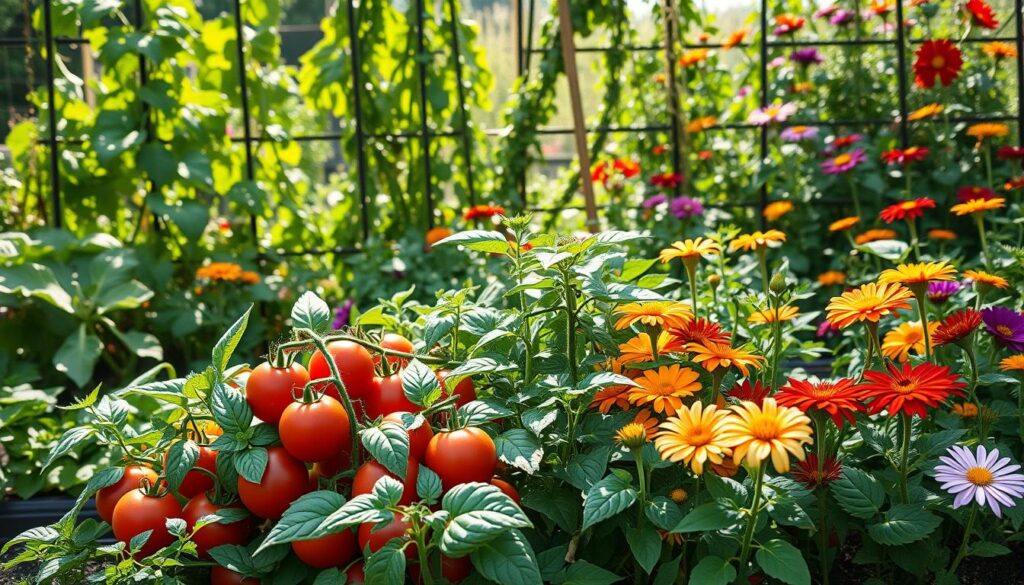
Maintaining Your Companion Plant Garden
Maintaining a thriving companion plant garden requires dedication and attention to detail. Applying effective garden maintenance tips can help you keep your plants healthy while maximizing their benefits to each other. Focus on regular tasks such as watering, pruning, and monitoring for pests or diseases, ensuring the well-being of both watermelons and their companion plants.
Regular Care and Maintenance Tips
To ensure your garden flourishes, implement the following care strategies:
- Water regularly, especially during dry spells, to keep the soil moist.
- Test the soil periodically for its nutrient levels to provide appropriate fertilizers.
- Prune overgrown companion plants to maintain airflow and reduce competition for resources.
- Inspect frequently for pests or diseases and take immediate action if detected.
Troubleshooting Common Issues
Despite your efforts, issues may arise in your companion plant garden. Some common problems include:
| Issue | Symptoms | Solutions |
|---|---|---|
| Nutrient Deficiencies | Poor growth, yellowing leaves | Apply appropriate organic fertilizers based on soil tests. |
| Pest Infestations | Visible insects, wilting plants | Utilize insecticidal soap or introduce beneficial insects. |
| Overcrowding | Stunted growth, competition for resources | Space out plants appropriately and prune as necessary. |

Success Stories: Real-Life Companion Planting
Exploring gardening success stories reveals how companion planting enhances the growth of watermelons and their neighbors. Many gardeners have shared their companion planting experiences, highlighting the practicality and creativity in combining different plants for optimized results.
Testimonials from Gardeners
Numerous testimonials emphasize the positive impacts of companion planting in home gardens. For instance, one gardener noted that planting basil alongside watermelons improved flavor and deterred pests effectively. Another shared that marigolds acted as a natural barrier, leading to healthier grape vines nearby.
Benefits Seen in Home Gardens
The benefits of companion planting extend beyond just pest management. Many home gardeners report increased yields and more robust plants. Gardening success stories often include improved soil health and less frequent watering needs, demonstrating the synergistic effects of combining different plant species.

| Gardener | Companion Plants Used | Results |
|---|---|---|
| Sarah | Basil, Marigolds | Enhanced flavor, reduced pests |
| Tom | Cilantro, Radishes | Improved health, boosted yields |
| Amy | Cucumbers, Sunflowers | Effective shading, attracted pollinators |
Through the sharing of these companion planting experiences, gardeners encourage others to adopt similar methods, emphasizing that teamwork among plants can yield fruitful results.
Conclusion: Maximizing Your Watermelon Harvest with Companion Plants
Integrating the right companion plants into your watermelon garden can significantly boost productivity and health. By selecting plants that complement one another, you can create a more sustainable environment that allows for greater growth and resilience in your watermelon patch. To fully utilize your space and maximize yields, understanding the interactions between various plants is essential. Watermelon gardening insights will empower you to explore diverse planting strategies that enhance both flavor and bounty.
Recap of Key Points
- Companion plants improve soil health and pest management.
- Choosing the right companions can significantly enhance watermelon growth.
- Experimentation leads to discovering the best combinations tailored to your garden.
Encouragement to Experiment
Gardening is as much about creativity as it is about technique. Don’t hesitate to experiment with different companion plants and observe how they interact with your watermelons. With each planting season, you create an opportunity to learn and adapt your methods. Use the knowledge gained from watermelon gardening insights to fine-tune your approach and ultimately enjoy a more fruitful harvest.

Additional Resources for Companion Planting
As you embark on your journey into companion planting, having access to the right gardening resources can make a significant difference in your success. Whether you’re looking for detailed guides, insightful books, or vibrant online communities, there’s a wealth of information available to help you cultivate a thriving garden. These resources can not only enhance your knowledge but also connect you with like-minded gardeners who share your passion.
Books and Guides to Explore
Diving into books specifically focusing on companion planting can provide you with in-depth understanding and practical tips. Titles from trusted authors like Louise Riotte, known for her excellent work on beneficial plant pairings, are worth considering. Additionally, comprehensive guides from gardening organizations can offer structured insights on effectively utilizing companion plants to improve your harvest. The right literature can serve as both an introduction for beginners and a reference for seasoned gardeners.
Online Communities and Forums
Joining online communities and forums dedicated to companion planting can be incredibly rewarding. These platforms allow you to engage with fellow gardening enthusiasts, share experiences, and seek advice tailored to your specific challenges. Participating in discussions within companion planting communities not only expands your knowledge but also helps you stay motivated as you grow your garden. The connections you make can lead to lifelong friendships, enriching your gardening journey.









